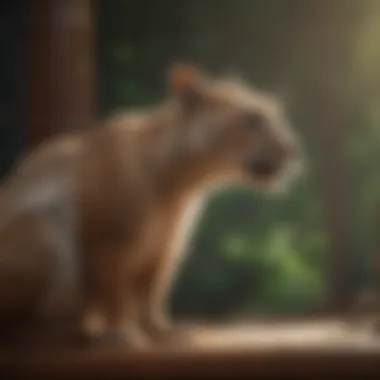Wildlife Protection: Key to Biodiversity Conservation


Intro
Wildlife protection plays a vital role in conserving biodiversity. Given the increasing rate of species extinction, understanding its significance is imperative. Biodiversity, which encompasses the variety of life forms on Earth, is crucial for maintaining ecological systems. Its loss can lead to degraded ecosystems, affecting human societies and natural processes alike. This article will explore various aspects of wildlife protection, examining threats, methodologies, community engagement, and technological innovations that bolster conservation efforts.
Overview of Research Topic
Brief Background and Context
In recent decades, there has been significant degradation of wildlife habitats due to factors such as climate change, pollution, and human encroachment. The situation is dire—estimates suggest that more than one million species face the threat of extinction. Habitat destruction, overexploitation, and invasive species contribute heavily to this crisis. As a result, wildlife protection is not only a moral imperative but also essential for preserving our planet's biological richness.
Importance in Current Scientific Landscape
The ongoing discourse surrounding wildlife protection reflects its importance in the scientific community. Researchers recognize that biodiversity loss affects ecosystem services, which include food production, clean water, and climate regulation. Protecting wildlife can help maintain these essential services, thus promoting human well-being alongside ecological stability. The intersection of wildlife protection and biodiversity conservation is a crucial focal point for scientists, policymakers, and conservationists alike.
Methodology
Research Design and Approach
This article employs a systematic review approach, synthesizing existing literature on wildlife protection and its impact on biodiversity. It interrogates various studies and reports to illustrate the current understanding of threats and conservation practices. The objective is to provide a comprehensive overview while identifying gaps in knowledge that warrant further exploration.
Data Collection Techniques
Data is gathered from multiple sources, including:
- Academic journals
- Government and NGO reports
- Case studies of successful wildlife protection initiatives worldwide
- Online forums and discussions on platforms like Reddit
Each source contributes to understanding the complexities of wildlife protection and the myriad factors affecting biodiversity. By consolidating information from disparate channels, the article aims to present a cohesive narrative that highlights the vital role of effective wildlife protection.
"Without wildlife protection efforts, biodiversity can swiftly decline, leading to significant consequences for ecological balance."
In summary, understanding the crucial role of wildlife protection requires looking at threats, methodologies, and community involvement comprehensively. Through this exploration, we can highlight the connection between wildlife and human wellbeing and underscore the necessity for sustained action towards conservation.
Foreword to Wildlife Protection
Wildlife protection serves as a cornerstone for biodiversity conservation. This section addresses essential concepts that contribute to understanding why wildlife protection is imperative. It brings clarity to the issues surrounding wildlife conservation and emphasizes its multifaceted nature, involving ecological, legal, and socioeconomic dimensions.
Effective wildlife protection ensures that ecosystems remain balanced. When animal and plant species thrive, they contribute to ecological stability, which in turn supports human survival and quality of life. The loss of wildlife can lead to cascading effects in the environment, manifesting in problems such as soil degradation and diminished water quality. Therefore, protecting wildlife is not merely an environmental concern but also a public health issue.
Additionally, wildlife protection highlights the interconnectedness of various species and their habitats.
Defining Wildlife Protection
Wildlife protection refers to a set of practices and measures aimed at conserving wild animals and their habitats. This includes legal frameworks, conservation strategies, and community engagement efforts that seek to limit harmful practices, such as poaching and habitat destruction.
The importance of a clear definition lies in its role in guiding policies and actions that aim to safeguard endangered and threatened species. It also helps establish the criteria for identifying areas needing protection, thus enabling targeted conservation initiatives. Within this scope, wildlife protection incorporates various elements, including:
- Legislation: Creating laws that prohibit illegal hunting and trading of species.
- Protected areas: Establishing reserves that provide sanctuary for various wildlife types.
- Community involvement: Engaging local populations to play an active role in conservation efforts.
Historical Context
The practice of wildlife protection is not modern; it has deep historical roots. Ancient civilizations often recognized the need to conserve wildlife for spiritual and practical reasons. Many cultures had taboos against hunting certain species, providing a primitive yet effective form of wildlife protection.
As societies evolved, the industrial revolution brought significant environmental challenges. Deforestation, pollution, and urbanization began altering natural habitats at an alarming rate. In response, the late 19th and early 20th centuries saw the establishment of the first wildlife protection laws and parks in various countries. For example:
- In 1900, the Lacey Act was enacted in the United States, marking a crucial moment in the nation's wildlife protection efforts.
- The founding of national parks signified an acknowledgment of the need to conserve natural habitats for future generations.
This historical context illustrates how the perception of wildlife protection has changed over time and underlines the ongoing need for vigilance in conservation efforts.
Current Global Challenges in Wildlife Protection
The present landscape of wildlife protection is marked by various critical challenges that hinder effective conservation efforts. Understanding these challenges is vital for students, educators, researchers, and professionals involved in ecological and environmental fields. This section will detail significant factors that threaten wildlife, which include habitat loss, climate change impacts, poaching, the illegal wildlife trade, and invasive species. Not only do these challenges disrupt ecosystems, but they also impede human well-being and long-term survival. The interconnected nature of these issues highlights the need for comprehensive strategies to combat them effectively.
Habitat Loss and Degradation
Habitat loss and degradation present some of the most pressing challenges in wildlife protection. The expansion of urban areas, agricultural development, and infrastructure projects rapidly alter or destroy natural habitats. Forests are being cleared for timber and agricultural land, wetlands drained for development, and grasslands converted into pastures. This encroachment results in fragmentation of habitat, which can isolate animal populations and reduce genetic diversity.
Moreover, degradation of habitats occurs through pollution and human-induced climate change. Natural ecosystems are being compromised, making these areas inhospitable for many species. Species that cannot adapt quickly to these changes are at risk of extinction. It is evident that the protection of natural habitats is not only crucial for wildlife but also for humanity, as ecosystems provide essential services such as clean air and water.
Climate Change Impacts


Climate change fundamentally alters ecosystems and the species that inhabit them. Rising temperatures, erratic weather patterns, and increased frequency of extreme events lead to shifts in habitats and biological communities. For example, many species are forced to move to higher altitudes or latitudes in search of suitable climates. Such movements can disrupt established ecosystems and lead to further biodiversity loss.
Additionally, climate change affects reproductive cycles, migration, and food availability for species. Coral reefs, which support immense diversity, are particularly vulnerable, experiencing bleaching events due to warming waters. The cascading effects of climate change on wildlife further emphasize the dire need for robust responses from both governmental and non-governmental organizations.
Poaching and Illegal Wildlife Trade
Poaching and the illegal wildlife trade are major threats that result in the rapid decline of many species, including iconic ones like elephants and rhinoceroses. Driven by demand for animal parts, such as ivory and horns, poachers operate in many regions with alarming frequency. The profits from illegal wildlife trade rival those of the drug trade, indicating the enormity of this problem.
Besides the immediate threat to populations, poaching undermines conservation efforts in broader ways. It hampers the maintenance of ecosystems, leading to unbalanced predator-prey dynamics and habitat degradation. Law enforcement alone cannot solve this problem; education and community engagement are essential to addressing the root causes behind poaching.
Invasive Species
Invasive species are another challenging factor in the realm of wildlife protection. These non-native organisms can outcompete local species for resources, disrupting food webs and altering habitats. As globalization continues, the risk of invasive species introduction increases, leading to unforeseen consequences.
Invasive species can diminish biodiversity, alter ecosystem processes, and lead to the extinction of native species. This competition for resources often comes with a lack of natural predators or constraints that native species have evolved against. The fight against invasive species requires an understanding of their biology and ecology, as well as cooperation among various stakeholders to manage and control these species effectively.
Effective wildlife protection hinges on a nuanced understanding of these global challenges. Collaboration and innovative strategies are essential for developing solutions that balance ecological integrity with human interests.
The Importance of Biodiversity
Biodiversity refers to the variety of life forms on Earth, encompassing different plants, animals, ecosystems, and genetic variation within species. Its importance cannot be overstated. Biodiversity provides essential services that support life, contributing to ecological balance and human prosperity. The richness of species and ecosystems offers resilience to changes and shocks, making it vital for sustaining Earth's life support systems.
Ecosystem Services
Ecosystem services are the benefits humans derive from nature, and they can be classified into four main categories: provisioning services, regulating services, cultural services, and supporting services.
- Provisioning Services: These include the supply of food, fresh water, wood, fiber, and genetic resources. Healthy ecosystems ensure a sustainable supply of these basic resources, crucial for human survival and economy.
- Regulating Services: This category involves the regulation of environmental conditions, such as climate regulation, flood control, and disease prevention. For example, wetlands filter pollutants and mitigate floods, while diverse forests help sequester carbon, thus combating climate change.
- Cultural Services: Biodiversity enriches our lives by providing recreational, aesthetic, and spiritual benefits. Natural landscapes inspire art, foster mental health, and attract tourism. These cultural dimensions contribute to community identity and heritage.
- Supporting Services: These are the underlying processes necessary for the production of all other ecosystem services. Soil formation, nutrient cycling, and primary production are fundamental to maintaining the ecosystems on which humanity relies.
"Biodiversity underpins ecosystem services, which are fundamental to human well-being."
Cultural and Economic Value
Biodiversity has significant cultural and economic value. Societies around the world value wildlife and ecosystems for numerous reasons. From an economic perspective, biodiversity contributes to livelihoods through tourism, agriculture, and fisheries. For instance, ecotourism relies on the presence of rich wildlife and pristine habitats, generating income and jobs for local communities.
- Ecological Tourism: This innovative trend harnesses nature's beauty, fostering economic growth while promoting conservation. Destinations that showcase biodiversity attract visitors and encourage sustainable practices.
- Traditional Knowledge: Many indigenous and local communities depend on biodiversity for their cultural practices, traditional medicine, and food. This knowledge is often tied closely to specific species or ecosystems and can be crucial for enhancing food security and health.
The extinction of species and the decline of ecosystems threaten not only ecological stability but also cultural richness and economic opportunities. Protecting biodiversity thus becomes a critical priority to ensure that these valuable resources are available for future generations.
Frameworks for Wildlife Protection
Frameworks for wildlife protection are essential for biodiversity conservation. They create a structured approach for managing and conserving wildlife populations and their habitats. As threats to wildlife continue to escalate, effective frameworks become increasingly important. They provide guidelines, strategies, and legal backing for conservation efforts. Understanding different frameworks enables stakeholders to engage in informed discussions that shape wildlife conservation policies.
National Legislation
National legislation plays a significant role in wildlife protection. It serves as the primary legal framework for conservation within a country. Effective laws can regulate hunting, establish protected areas, and provide penalties for illegal wildlife trade. For example, the Endangered Species Act in the United States has successfully aided in the recovery of many species at risk of extinction.
Countries are encouraged to review and amend their wildlife protection laws regularly. It ensures they reflect ongoing research, changing ecosystems, and emerging threats. Additionally, effective national legislation requires the support and cooperation of enforcement agencies, local communities, and stakeholders.
Key points to consider regarding national legislation include:
- Legal definitions: Clear definitions of wildlife and conservation areas help prevent ambiguities in enforcement.
- Community involvement: Engaging local communities in the legislative process enhances support and compliance.
- Resources for enforcement: Adequate funding and training for wildlife law enforcement are critical for actualizing legal frameworks.
International Agreements
On a broader scale, international agreements facilitate cooperative efforts for wildlife protection. They help nations collaborate to address transboundary issues that affect wildlife conservation. Such agreements promote a consistent approach to wildlife protection across different jurisdictions.
A notable example is the Convention on International Trade in Endangered Species of Wild Fauna and Flora (CITES). This treaty regulates international trade of wildlife species to ensure their survival in the wild. Through CITES, countries commit to monitoring and controlling trade, which can significantly impact species at risk.
Another important agreement is the Convention on Biological Diversity (CBD). It focuses on the conservation of biodiversity, sustainable use of natural resources, and fair sharing of benefits arising from genetic resources.
- Shared responsibility: International agreements highlight the shared responsibility of countries in wildlife protection.
- Best practices: These frameworks promote the exchange of best practices and resources among member countries.
- Joint funding: They often facilitate joint funding initiatives for conservation projects, especially in developing countries.
"International cooperation is vital for addressing the challenges of wildlife protection in a globalized world. The threats know no borders, thus our solutions must span them too."
By aligning national and international frameworks, countries can create a more robust system that effectively protects wildlife and conserves biodiversity.
Conservation Strategies
Conservation strategies are essential frameworks designed to protect wildlife and habitats. The effectiveness of these strategies hinges on understanding not only environmental needs but also human factors that influence biodiversity. By implementing focused measures such as creating protected areas, promoting sustainable land use, and engaging communities, we can significantly contribute to wildlife conservation. Each of these elements plays a vital role in maintaining the delicate balance of ecosystems, which is crucial for the health of our planet.


Protected Areas and Reserves
Protected areas and reserves act as sanctuaries for wildlife. By designating specific regions for conservation, there is a reduction in habitat destruction and human encroachment. According to the IUCN (International Union for Conservation of Nature), nearly 15% of the Earth's terrestrial areas are recognized as protected. This strategy serves multiple purposes:
- Biodiversity Preservation: Protected areas safeguard a wide range of species, ensuring that they can thrive in their natural habitats.
- Ecosystem Services: They contribute to ecosystem services such as water filtration, carbon storage, and soil preservation.
- Cultural Heritage: Many reserves also protect historical and cultural sites, enriching community identity.
However, establishing protected areas is only part of the solution. Ensuring they are effectively managed and funded is key to their success. Regular monitoring and adaptive management practices can enhance these efforts.
Sustainable Land Use Practices
Sustainable land use practices strive to find a balance between development and conservation. This approach is increasingly vital as urbanization and agriculture expand into wild areas. Some key elements include:
- Agroforestry: Combining agriculture with forestry can enhance biodiversity. This practice allows for diverse species to coexist while providing economic benefits.
- Responsible Sourcing: Encouraging businesses to adopt sustainable materials and practices can minimize harmful impacts on wildlife habitats.
- Land Restoration: Efforts to rehabilitate degraded landscapes not only restore habitats but also enhance carbon sequestration.
By integrating these sustainable practices into land use planning, we can mitigate negative effects on ecosystems and ensure wildlife thrives alongside human development.
Community-Based Conservation
Community-based conservation emphasizes local participation in wildlife protection. Involving communities creates vested interests in conservation outcomes. Here are important aspects:
- Local Knowledge: Residents often possess invaluable knowledge about local ecosystems and species, which can inform more effective conservation practices.
- Economic Incentives: Providing communities with economic benefits from conservation, such as eco-tourism or sustainable harvesting, encourages stewardship of natural resources.
- Conflict Resolution: Engaging local stakeholders helps address conflicts between wildlife needs and human interests, fostering coexistence.
Such strategies not only empower communities but also promote long-term conservation goals. Collaborative efforts between governments and local populations can lead to transformative impacts within ecosystems.
"The path to conservation is not just about protecting wildlife; it is about sharing the responsibility with those who live closest to nature."
Role of Technology in Wildlife Conservation
Technology plays a pivotal role in wildlife conservation, addressing challenges faced by various species and ecosystems. This section delves into the avenues through which modern advancements improve our efforts in wildlife protection, emphasizing the significance of monitoring, data collection, and anti-poaching technologies. The integration of technology not only enhances efficiency but also extends the reach of conservation efforts, providing tools that enable proactive and informed actions.
Monitoring and Data Collection
Accurate monitoring and data collection are essential for effective wildlife conservation. Technologies such as remote sensing, camera traps, and drones allow researchers to gather vital data about wildlife populations and their habitats. Such innovations enable continuous observation without significant disturbance to the animals' natural behavior.
- Remote Sensing: Satellite imagery helps in observing land cover changes and habitat destruction over time. This data is crucial in understanding the environmental impacts of human activities.
- Camera Traps: These devices capture images and videos of wildlife, providing insights into behavior, population dynamics, and species distribution. They help biologists assess the status of various species that might be elusive or endangered.
- Drones: Unmanned aerial vehicles offer a unique perspective by covering vast areas quickly. This technology helps in mapping habitats, monitoring populations, and even locating species in difficult terrain.
The data collected from these technologies aids in making informed decisions about conservation strategies. It allows environmental organizations and governments to identify trends, set priorities, and allocate resources effectively.
"Technology transforms how we understand and protect wildlife, making solutions more targeted and impactful."
Anti-Poaching Technologies
Poaching remains a significant threat to wildlife, driven by illegal demand for animal products. In response, various anti-poaching technologies have arisen, providing critical support in the fight against this pervasive issue.
- Electronic Surveillance: Systems like thermal cameras and infrared sensors assist in detecting movements within protected areas, especially at night. These tools help rangers monitor activities and respond to threats swiftly.
- Tracking Devices: GPS collars and tags enable real-time tracking of endangered species. Knowing the location and movements of animals helps authorities coordinate protective measures in real-time, reducing the risk of poaching.
- Mobile Apps: Applications designed for reporting wildlife sightings and suspicious activities empower local communities. Engaging the public in conservation efforts enhances reporting and surveillance, often leading to immediate action.
The implementation of such technologies showcases a multi-faceted approach to combating poaching. Engaging local communities through technology not only heightens awareness but also strengthens their role in conservation.
Successful Case Studies
Successful case studies in wildlife protection provide vital insights into effective conservation strategies. They demonstrate not just the theoretical frameworks but also practical implementations and outcomes in various contexts. These examples can inspire further efforts across regions and motivate communities to engage in conservation practices. Understanding these case studies helps in identifying critical factors for success, including community involvement, legislative support, and adaptability of strategies to local conditions.
Gebrselassie: A Model of Community Participation
The Gebrselassie community initiative serves as an exemplary model for engaging local populations in wildlife protection. Located in a region where poaching and habitat loss have been rampant, this initiative emphasizes the critical role of local communities in sustainable conservation efforts.
The Gebrselassie project was initiated with a simple yet impactful premise: empower local people. This involved education, training, and offering alternative livelihoods that do not conflict with wildlife conservation. By doing so, the initiative not only raised awareness about the importance of biodiversity but also created a vested interest within the community to protect their natural environment.
Key elements of this successful case study include:
- Capacity Building: Community members were educated about local wildlife and ecosystems, allowing them to become stewards of the land.
- Economic Incentives: Programs were implemented that provided income opportunities through ecotourism, thus linking financial benefit with wildlife preservation.
- Engagement in Decision-Making: The local community was encouraged to participate in planning and implementing conservation measures.
As a result, reports indicated a decrease in poaching incidents and an increase in local wildlife populations. This case underlines the profound impact of community involvement in wildlife protection.
Recovery of the Arabian Oryx
The Arabian Oryx recovery project stands as a significant success story in wildlife conservation. Once declared extinct in the wild in the 1970s, intensive conservation efforts led by the Dubai Desert Conservation Reserve and other organizations helped revive its population. This case exemplifies how targeted actions can lead to remarkable changes in wildlife numbers.
The recovery process involved:


- Captive Breeding Programs: Breeding was initiated in controlled environments to ensure a stable population.
- Habitat Restoration: Efforts were made to restore and protect the oryx's natural habitat. This included the creation of protected areas free from human interference.
- Reintroduction to the Wild: Once a sufficient population was achieved in captivity, a strategic reintroduction to their natural habitat took place. This involved careful monitoring and management of the environment to support their survival.
Today, the Arabian Oryx population has grown, and the species has been downlisted from extinct to vulnerable. This remarkable comeback highlights the importance of structured conservation strategies and the direct benefits of wildlife protection efforts. It shows that with the right approach, threatened species can recover effectively, thereby contributing to biodiversity conservation overall.
This case study illustrates the potential for successful wildlife recovery through meticulous planning, dedication, and strategic implementation.
The Role of Education and Awareness
Education and awareness are key components in the fight for wildlife protection and biodiversity conservation. In many parts of the world, people are simply unaware of the important role that wildlife plays in maintaining ecological balance. Increasing knowledge about wildlife habitats, ecosystems, and the threats they face can foster a sense of responsibility among individuals and communities.
Informed citizens are more likely to engage in conservation efforts, whether through responsible tourism, local volunteering, or supporting legislation for wildlife protection. Education can also drive the demand for sustainable practices that minimize harm to wildlife. Schools, nature centers, and community organizations must actively promote understanding of local ecosystems and their inhabitants.
Promoting Responsible Tourism
Promoting responsible tourism is crucial for wildlife conservation. Tourism can offer significant economic support to local communities, but it must be executed thoughtfully. Tourists can negatively impact wildlife habitats through pollution, disturbance, and over-visitation. Therefore, educating travelers about the principles of responsible tourism is essential.
- Wildlife Guidelines: Tour operators should provide guidelines that encourage respect for wildlife and habitats.
- Cultural Sensitivity: Education on the cultural significance of wildlife to local populations helps foster respect among visitors.
- Support Local Economies: Tourists should be directed towards businesses that prioritize sustainable and ethical practices.
A coherent tourism strategy that emphasizes conservation can enhance the benefits of wildlife tourism, aligning visitor interests with ecological integrity.
Engaging the Younger Generation
Engaging the younger generation is critical as they are the future stewards of the Earth. Education systems should incorporate comprehensive programs on wildlife, conservation, and environmental stewardship. By fostering early awareness, children can develop a lifelong appreciation and advocacy for wildlife protection.
Strategies to engage the younger generation include:
- Interactive Learning Activities: Outdoor educational programs that provide hands-on experiences can make learning more impactful.
- Digital Platforms: Utilizing social media and other digital platforms can disseminate information effectively and reach a larger audience.
- Partnerships with NGOs: Collaborations between schools and non-profits can yield resources and programs that promote conservation activities.
Challenges Ahead
As we examine the complex landscape of wildlife protection, it becomes clear that several formidable challenges must be addressed to ensure the long-term success of biodiversity conservation efforts. The tension between ecological integrity and socio-economic advancement presents a critical focus. This section will unpack the nuances of balancing development and conservation, as well as addressing global inequality. These challenges are not merely obstacles; they highlight the intricate connections between human activities and environmental health.
Balancing Development and Conservation
The first challenge we examine is the need to reconcile development with conservation initiatives. Economic growth often relies on resource extraction, land development, and industrial expansion. Unfortunately, these practices can lead to habitat destruction, placing immense pressure on wildlife populations. Striking a balance between advancing economic interests and safeguarding ecosystems is a complex task that demands careful consideration.
To navigate this challenge, multi-disciplinary approaches are essential. Governments and policymakers should emphasize sustainable development practices, ensuring that natural habitats are preserved while allowing for economic opportunity. This may involve implementing strict zoning laws and promoting eco-friendly industries that do not compromise ecological systems.
Here are some strategies that can enhance this balance:
- Integrated Land Use Planning: This ensures that land development takes wildlife needs into account.
- Economic Incentives for Conservation: Offering tax breaks or grants for businesses that contribute to wildlife protection can encourage more sustainable practices.
- Public Awareness Campaigns: Informing communities about the benefits of conservation can create support for development strategies that prioritize environmental health.
Addressing Global Inequality
The second challenge focuses on global inequality, which has significant implications for wildlife conservation. Regions facing socio-economic hardship often prioritize short-term economic gains over sustainable practices. Consequently, these areas are frequently subjected to unsustainable resource exploitation, often leading to a rapid decline in biodiversity.
To address inequality, it is crucial to empower local communities. Engaging residents in conservation efforts can yield positive outcomes by fostering a sense of ownership and responsibility towards their environment. This approach not only alleviates poverty but also aligns human aspirations with conservation goals.
Key actions to combat global inequality in the context of wildlife protection include:
- Strengthening Community Rights: Recognizing and enforcing the rights of indigenous and local communities to manage their natural resources plays a pivotal role in conserving biodiversity.
- Funding and Educational Programs: Providing financial support and education to vulnerable communities allows them to engage in sustainable practices while reducing reliance on harmful activities.
- Collaborative Conservation Initiatives: Partnerships between non-profit organizations, governments, and local communities can amplify the collective impact on biodiversity conservation, ensuring more equitable outcomes.
"The need for equity in conservation efforts cannot be overstated. When local communities are harmonized with conservation goals, the likelihood of successful wildlife protection increases."
End and Call to Action
In closing, the urgency of protecting wildlife is clearer than ever. Without immediate action, we risk losing essential biodiversity that sustains ecosystems and human well-being. This article has highlighted the critical issues surrounding wildlife protection and underscored the multifaceted approach required to tackle these challenges. Effective conservation is not just about preserving animal species; it encompasses a wide variety of factors, including habitat preservation, sustainable practices, and community engagement.
Wildlife protection serves as a crucial pillar for biodiversity conservation. It contributes directly to maintaining ecosystem balance and health. Recognizing the interdependence of species and their habitats is essential. Through concerted efforts and innovative strategies, stakeholders can help mitigate threats to wildlife. By fostering collaboration among governments, non-profit organizations, scientists, and local communities, we pave the way for better outcomes.
"In nature's economy, the currency is not money, it is life."
— Vandana Shiva
Collaborative Efforts
Successful wildlife protection and biodiversity conservation rely heavily on collaborative efforts across various sectors. Governments must formulate and enforce laws that prioritize environmental sustainability. Engaging non-profit organizations can enhance outreach and education. These organizations often bring expertise and resources that can lead to more effective strategies.
Community involvement is equally important. Local populations have valuable insights into surrounding ecosystems. Their participation can lead to stewardship that benefits both wildlife and the human community. Collaborative efforts can include:
- Partnerships between local communities and conservationists for sustainable management.
- Joint ventures that facilitate funding for conservation projects.
- Educational programs aimed at raising awareness about wildlife issues and promoting responsible behaviors.
The Path Forward
Looking ahead, a strategic approach is necessary to address the current challenges in wildlife protection. Several key considerations must guide future actions:
- Data-Driven Decision Making: Gathering and analyzing data on wildlife populations and habitat conditions is imperative. This informs effective policy development and resource allocation.
- Legislation Strengthening: Strengthening national and international laws concerning wildlife trade and poaching is crucial. This includes rigorous enforcement measures to deter illegal activities.
- Technological Innovation: Embracing technology, such as drones and camera traps, can improve monitoring and protection efforts. These tools can provide real-time data for better decision-making.
- Community Resilience Programs: Building adaptable communities can enhance conservation efforts. Supporting economic alternatives that do not rely on wildlife exploitation is necessary for long-term sustainability.
- Enhanced Communication: Promoting transparency and dialogue among stakeholders is vital for collaborative efforts. Engaging different perspectives can inspire more innovative solutions.
The collaboration and innovation discussed here provides hope for the future of wildlife protection. Together, these steps can forge a path toward a resilient and balanced ecosystem, ensuring that wildlife continues to thrive for generations to come.



